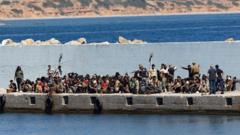In a significant archaeological breakthrough, researchers have unearthed the ancient city of Peñico, believed to be around 3,500 years old, which played a pivotal role as a trading center in ancient Peru.
Uncovering Peñico: A 3,500-Year-Old Trading City in Peru

Uncovering Peñico: A 3,500-Year-Old Trading City in Peru
Archaeologists reveal groundbreaking discovery of an ancient city in Peru, shedding light on pre-Columbian civilizations.
Archaeologists have recently unveiled an ancient city named Peñico, located in Peru's northern Barranca province, which dates back 3,500 years. This site acts as a vital connection between the Pacific coastal communities and the inhabitants of the Andes mountains and the Amazon basin. Positioned approximately 200 kilometers north of Lima, Peñico is thought to have been established between 1,800 and 1,500 BC, coinciding with significant early civilizations flourishing across the globe, including those in the Middle East and Asia.
The discovery, made after eight years of exploration, revealed a circular structure at the heart of Peñico along with 18 additional structures, including ceremonial temples and residential buildings. Archaeologists uncovered various artifacts, such as ceremonial objects, clay sculptures of both human and animal figures, and intricate necklaces fashioned from beads and seashells.
Peñico lies near the site of Caral, recognized as the Americas' oldest civilization, founded roughly 5,000 years ago around 3,000 BC in the Supe Valley of Peru. Caral is known for its monumental structures, including pyramids, sophisticated agricultural practices, and urban settlements that developed autonomously from contemporaneous civilizations in India, Egypt, Sumeria, and China.
Dr. Ruth Shady, the leading archaeologist of the Peñico discovery and earlier excavations at Caral, emphasized the significance of this find in understanding the legacy of Caral and its civilization, particularly after it faced the devastating impacts of climate change. “Peñico was strategically located for trade and interaction with coastal, highland, and jungle societies,” she noted.
At a recent press conference, Marco Machacuay, a researcher from the Ministry of Culture, highlighted that Peñico signifies a continuation of the Caral society's legacy. Peru, rich in archaeological history, is also renowned for monumental sites such as the Inca citadel of Machu Picchu and the enigmatic Nazca Lines carved into the desert landscape.



















